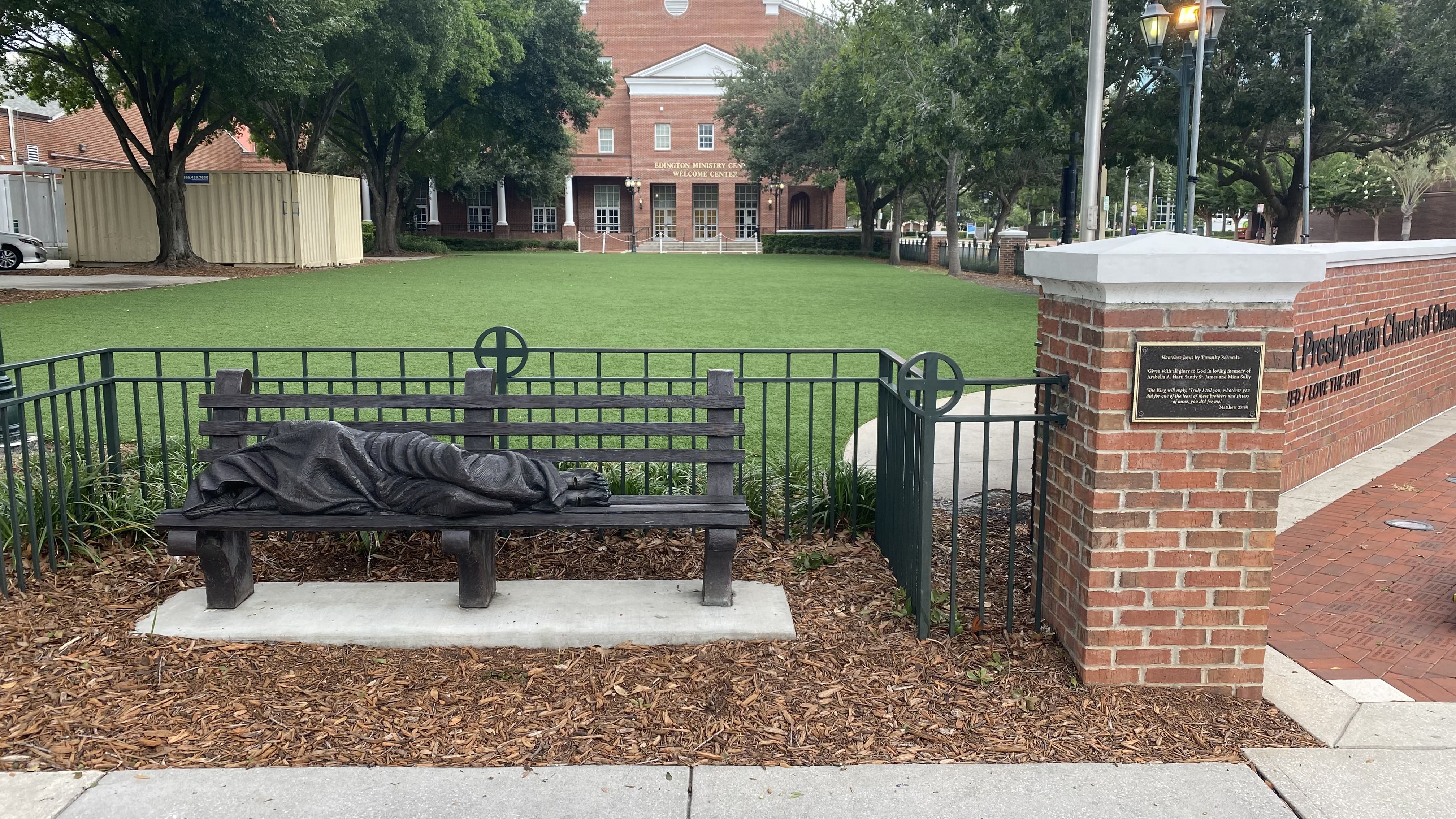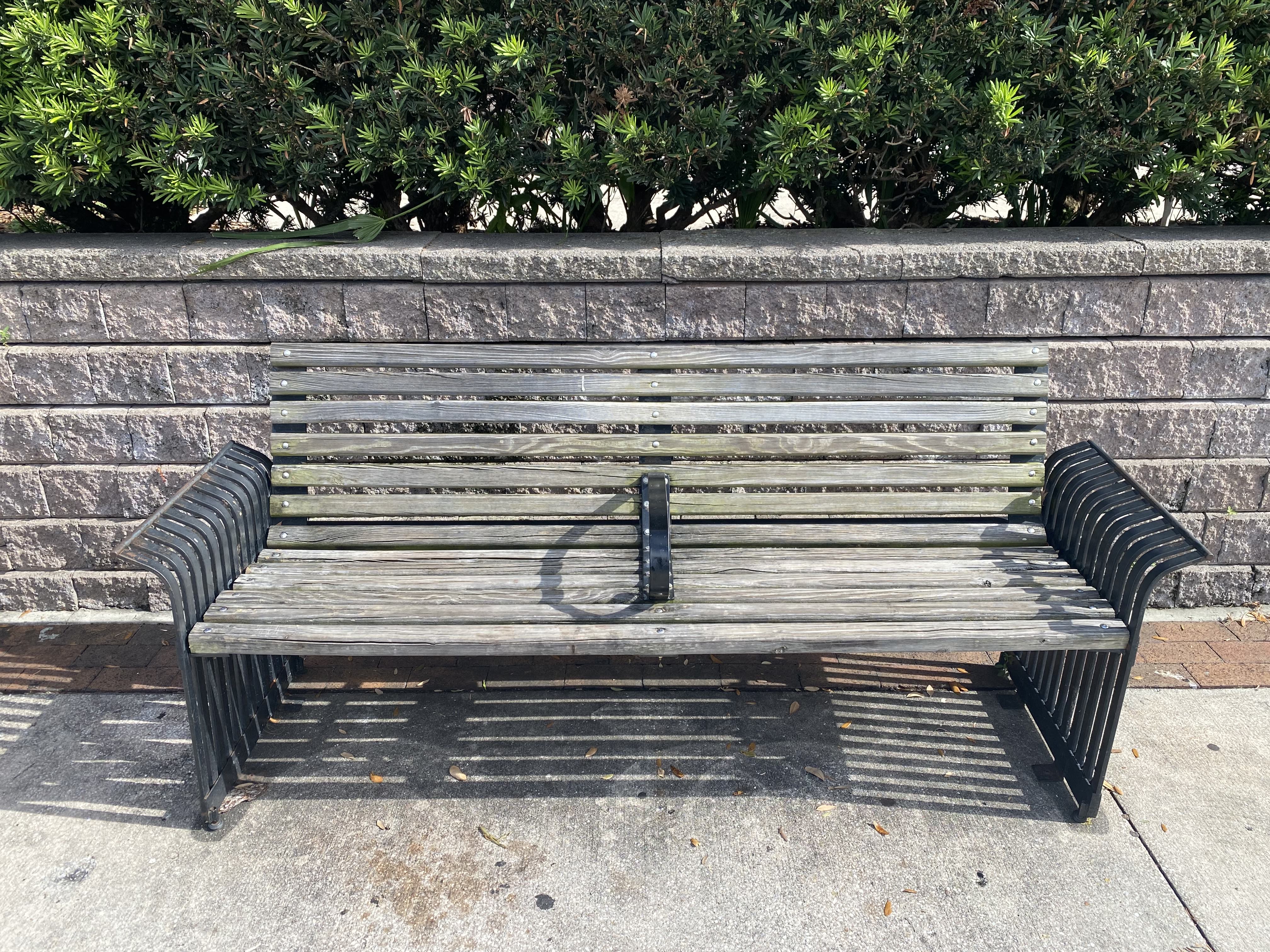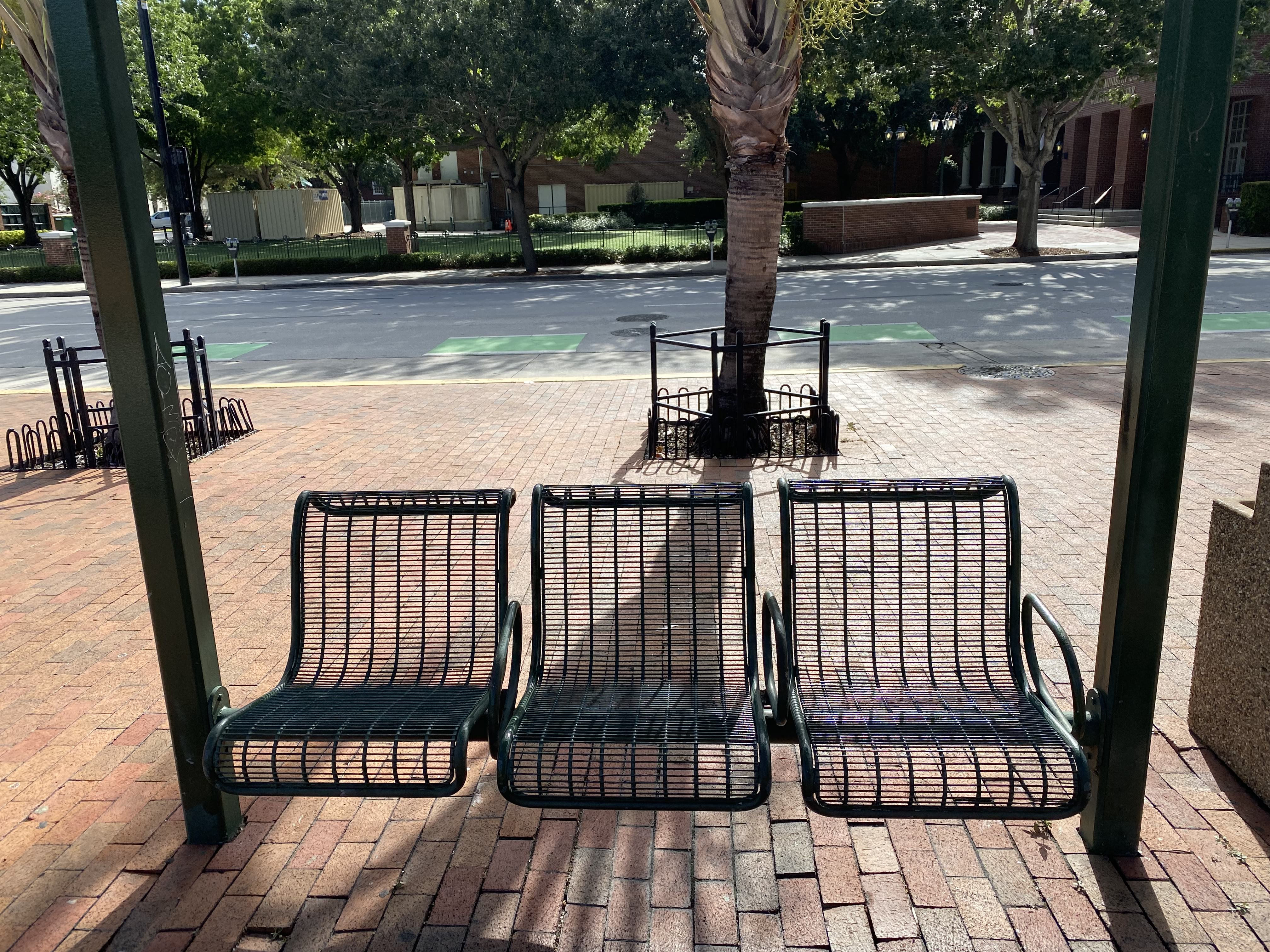jesus won't stop hogging the bench
Jul 18 2023
politics, architecture, art
Statement pieces are for the fortunate.
Correction (03-30-2024): The original version of this piece incorrectly attributed a quote by Rev. David Buck - the rector of a church with an installation of “Homeless Jesus” on the premises - to Timothy Schmalz, the sculptor of the statue. This mistake has been corrected.
I have always had an admiration for artists who work with physical space. It demands a level of commitment that I often struggle to muster - every decision carries more weight because of the enormous difficulty of starting over. Works meant for populated urban environments are even more fraught, as the artist has little to no control over the context they are presented in. People, cars, other buildings, and the entire city are in constant metamorphosis, and the piece itself has to fight tooth and nail to retain its originally intended meaning.
A few weeks ago, I saw a piece lose that fight.
 A photo depicting a man in rags huddled on a bench.
A photo depicting a man in rags huddled on a bench.
I saw the piece shown above a while ago while finishing a downtown trip with my mother. The picture you are seeing was taken well after I saw it for the first time, intentionally framed to capture the entire piece - but when my mother and I passed this statue, it was at night, and we did not have the time to stop to examine it. Nonetheless, we both noticed the installation from down the sidewalk as we approached it. We assumed that it was a homeless person sleeping on a bench, but as we drew closer, it became clear that it was merely a statue depicting a homeless person sleeping on a bench.
My mother and I exchanged looks of mutual bewilderment and kept walking. I racked my brain to find a reason why someone might build something like this, but my memory was jogged on the way back to the car when I saw an actual bench, and it looked like this.
 An park bench with a metal separator in the middle.
An park bench with a metal separator in the middle.
As we walked back to the car that night, I convinced myself for a moment that this statue was not a statue, but a bold new innovation in hostile architecture so boundlessly cruel as to be almost comical: building benches with the homeless people pre-installed. I wanted to believe that such a thing would never exist, but the story of the last five years has been a series of underestimating the world’s capacity for lunacy and being spectacularly proven wrong with the nihilistic glee of an Always Sunny cold open. “The Gang Builds A Fake Homeless Person” was just slightly too plausible a premise to dismiss out of hand.
As with most random minutiae that infuriate me, I took my findings to the group chat, and was informed by a friend that this bench was not a bench at all - it was an art piece. The person on the bench wasn’t just “a homeless person”. It was meant to be Jesus Christ.
“Homeless Jesus” is an installation by Canadian sculptor Timothy Schmalz that was first installed at the University of Toronto in 2013. As it turns out, it is not intended to be the extended end-zone dance on the homeless that I originally understood it as. It is actually intended to force a confrontation with Western society’s lack of compassion for the less fortunate.
Schmalz was very consciously trying to challenge the traditional depictions of “the Christ of glory, enthroned in finery.” The sculpture paints a picture of Jesus closer to the way he is frequently described in the Bible. “We believe that that’s the kind of life Jesus had,” said Rev. David Buck, a rector who supported installing the statue at his Davidson, North Carolina church. “He was, in essence, a homeless person.”
“Homeless Jesus” has been, by all accounts, wildly successful in making the point that Schmalz originally intended - both through its proponents and its detractors. The statue has been installed in several dozen churches, universities, and public spaces around the world, and it has provoked exactly the kind of reactions that Schmalz wanted to provoke - most notably when a Bay Village, Ohio resident called the police on the statue in October 2020, having mistaken it for an actual homeless person. Schmalz would be well within his rights to declare his artistic mission fully accomplished.
In theory, this new understanding of the installation, should have totally closed the book on my obsession with this baffling object, but it only amplified it. The message of the piece - that Jesus’s humble beginnings should remind us of the essential humanity of every person who’s been cast out by society - is not a bad one. It is as socially productive a message as any Christian church in modern America could be expected to muster, and given that I live in Florida, I see far less productive messages on the billboard of every highway. But understanding the purpose of the installation did not make me want to leave it alone, because it only made me ask a secondary question: if you’re a church leader who wants to demonstrate your commitment to universal love and generosity for the less fortunate, would it not be more useful to actually provide a real bench that a homeless person could sleep on, rather than an art display with the idea of a bench in it?
One must forgive me for assuming the worst of Schmalz’s statue. The landscape of hostile architecture in the United States is constantly and rapidly evolving, in no small part because it is a discipline that grows in proportion to our social maladies - of which we have many. New York City has street vents built with jagged surfaces to prevent sleeping on them. Literal spike fields erected under shaded entrances to buildings is not an uncommon sight. Many places have forgone the idea of “benches” entirely and instead installed “leaning bars” instead. This statue seemed like the logical next step - moving beyond mere practical cruelty and entering a bold new stage of self-conscious mockery. “You can’t sleep here,” the bronze Jesus says with a wink. “It’s already occupied.”
And, in spite of Schmalz’s intentions, the bench kind of does read that way - not because of how it presents itself but because of the context that it is presented in. Directly across the street from the statue is the Orange County Administration building, where one can find actual benches with separators in the middle to prevent the heinous crime of “laying in a horizontal position.” Standing on the intersection south of both of them, both the Homeless Jesus statue and the actual benches are in view.
 A bench-shaped object outside of the Orange County Administration Building. “Homeless Jesus” is just out of frame to the top left.
A bench-shaped object outside of the Orange County Administration Building. “Homeless Jesus” is just out of frame to the top left.
I am a mere heathen, but I’d imagine that Jesus Christ would probably not want to hog one of the only benches in downtown Orlando without a separator in the middle to prevent sleeping. It would remain illegal to “lay in a horizontal position” per city ordinance, but surely a genuine commitment to charity would not be restricted by the petty decrees of temporal authorities, especially when it would be cheaper and easier than sculpting an entire fake person to lay on a bench.
“Homeless Jesus” did exactly what Schmalz wanted to do. The fact that his piece takes on a secondary, more sinister meaning when placed in the context of the ceaseless march of urban inequality isn’t his fault, and it isn’t his problem. None of that changes the fact that - assuming the housing crisis continues to accelerate - the meaning the piece was meant to represent will be slowly replaced by the meaning of what the piece actually is in physical space: just another bench that keeps you from laying down. The slumbering Christ is a symbol only to the people who don’t actually need to sleep on it, because if you actually were homeless and did need to sleep somewhere, the bronze Jesus doesn’t “symbolize” anything - it is an actual, tangible barrier to shelter and comfort. The fortunate see a statement piece, but the downtrodden see the state.

